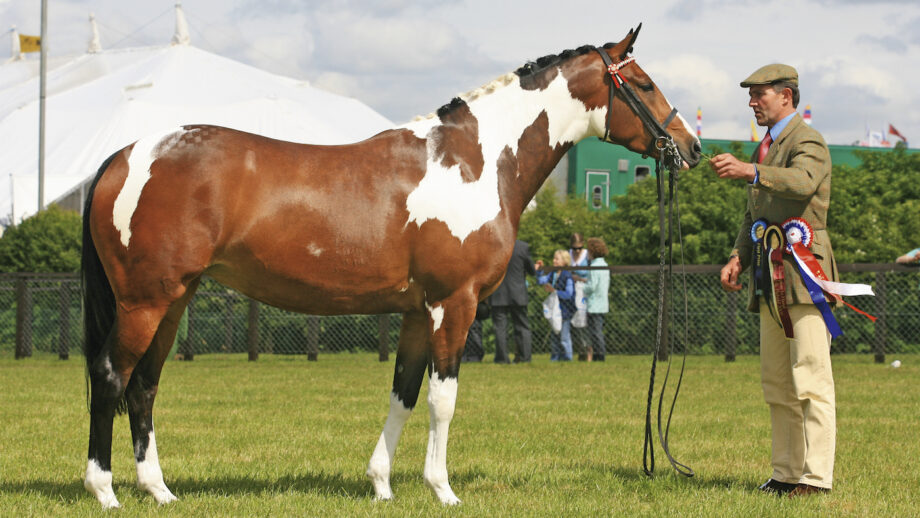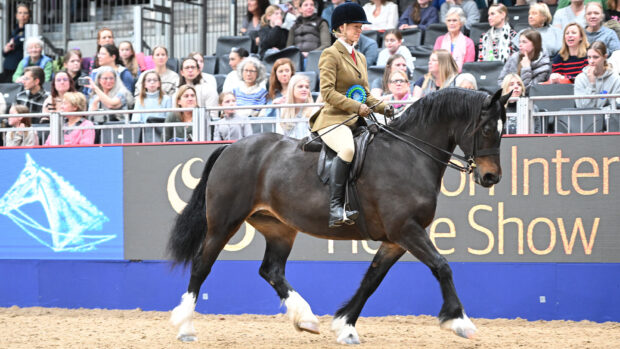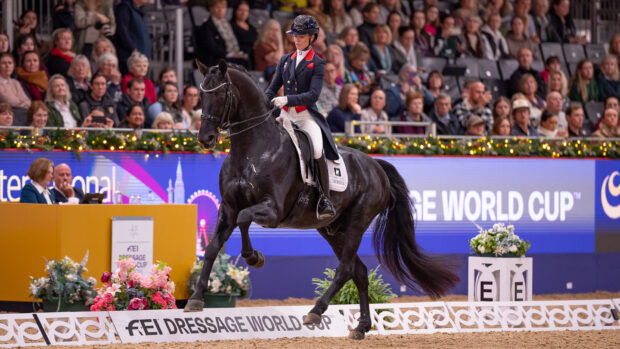Training for ridden native pony showing classes requires a specific approach to match the type, as well as plenty of practice to stand out in a competitive field. The native classes are undoubtedly the most popular and well-attended on the showing circuit. Today, mountain and moorland (M&M) flat and working hunter classes feature mammoth entries at shows up and down the country.
Classes for native ponies vary from the prestigious open breed finals at the Horse of the Year Show (HOYS) and the M&M Supreme Championship held at the London International Horse Show , to amateur-specific classes for home producers who juggle work with showing.
Some shows offer mixed M&M classes where all breeds compete against each other, while each of the breed societies hosts their own annual shows where you will see a venue filled with examples of just one breed of native.
Mini sections dedicated to M&M ponies are equally strong, with the small breeds often being a parent’s choice for their child’s lead-rein and first-ridden mounts.
With the correct training, many of the scopier and sportier types can make capable working hunter ponies, their native bravery and hardiness helping them fare well in this sphere.
6 key areas for training the ridden native pony
If you have a native pony to show during the coming season, winter and early spring is the perfect time to go back to basics and ensure their way of going is at the necessary level for success. H&H speaks to some of the circuit’s most successful producers who have won at all the major finals about the challenges you might face during training the ridden native pony and some tips on how to solve them.
{"content":"PGgzPjEuIEhlYXZ5IGluIHRoZSBmcm9udDwvaDM+CjxwPkNsYXJlIEZpdGNoIGlzIGEgc2hvd2luZyBwcm9kdWNlciB3aG8gaGFzIGVuam95ZWQgc3VjY2VzcyB0cmFpbmluZyBhbGwgdHlwZXMgb2YgcmlkZGVuIG5hdGl2ZSBwb255LiBTaGUgd2FzIGNyb3duZWQgTSZhbXA7TSByaWRkZW4gY2hhbXBpb24gYXQgSE9ZUyBpbiAyMDI0IHJpZGluZyBGZWxsIHN0YWxsaW9uIFdpbGRob2V2ZSBPa2kgRG9raS4gU2hlIGFsc28gd29uIHRoZSBIaWdobGFuZCBwb255IG9mIHRoZSB5ZWFyIGZpbmFsIGluIHRoZSBzYW1lIGRheSByaWRpbmcgVmFsZXJvY2sgTW9ucm9lLjwvcD4KPHA+PGJyIC8+CjxkaXYgaWQ9ImF0dGFjaG1lbnRfODg1NjE4IiBzdHlsZT0id2lkdGg6IDE0MTBweCIgY2xhc3M9IndwLWNhcHRpb24gYWxpZ25ub25lIj48aW1nIGZldGNocHJpb3JpdHk9ImhpZ2giIGRlY29kaW5nPSJhc3luYyIgYXJpYS1kZXNjcmliZWRieT0iY2FwdGlvbi1hdHRhY2htZW50LTg4NTYxOCIgY2xhc3M9Imxhenlsb2FkIGJsdXItdXAgc2l6ZS1mdWxsIHdwLWltYWdlLTg4NTYxOCIgZGF0YS1wcm9jZXNzZWQgc3JjPSJodHRwczovL2tleWFzc2V0cy50aW1laW5jdWsubmV0L2luc3BpcmV3cC9saXZlL3dwLWNvbnRlbnQvdXBsb2Fkcy9zaXRlcy8xNC8yMDE3LzAzL25ldy1oaC1wbGFjZWhvbGRlci0yMDB4MjAwLnBuZyIgZGF0YS1zcmM9Imh0dHBzOi8va2V5YXNzZXRzLnRpbWVpbmN1ay5uZXQvaW5zcGlyZXdwL2xpdmUvd3AtY29udGVudC91cGxvYWRzL3NpdGVzLzE0LzIwMjUvMDMvQ0xBUkVfRklUQ0hfTk9WMTgtMjk1NDdfMjUyODgyODYxXzM4MTg4MDg5MS5qcGciIGFsdD0iTmF0aXZlIHBvbnkgcHJvZHVjZXIgQ2xhcmUgRml0Y2ggd2l0aCB0d28gbmF0aXZlIHBvbmllcyIgd2lkdGg9IjE0MDAiIGhlaWdodD0iNzcwIiBkYXRhLXNpemVzPSJhdXRvIiBkYXRhLXNyY3NldD0iaHR0cHM6Ly9rZXlhc3NldHMudGltZWluY3VrLm5ldC9pbnNwaXJld3AvbGl2ZS93cC1jb250ZW50L3VwbG9hZHMvc2l0ZXMvMTQvMjAyNS8wMy9DTEFSRV9GSVRDSF9OT1YxOC0yOTU0N18yNTI4ODI4NjFfMzgxODgwODkxLmpwZyAxNDAwdywgaHR0cHM6Ly9rZXlhc3NldHMudGltZWluY3VrLm5ldC9pbnNwaXJld3AvbGl2ZS93cC1jb250ZW50L3VwbG9hZHMvc2l0ZXMvMTQvMjAyNS8wMy9DTEFSRV9GSVRDSF9OT1YxOC0yOTU0N18yNTI4ODI4NjFfMzgxODgwODkxLTMwMHgxNjUuanBnIDMwMHcsIGh0dHBzOi8va2V5YXNzZXRzLnRpbWVpbmN1ay5uZXQvaW5zcGlyZXdwL2xpdmUvd3AtY29udGVudC91cGxvYWRzL3NpdGVzLzE0LzIwMjUvMDMvQ0xBUkVfRklUQ0hfTk9WMTgtMjk1NDdfMjUyODgyODYxXzM4MTg4MDg5MS02MzB4MzQ3LmpwZyA2MzB3LCBodHRwczovL2tleWFzc2V0cy50aW1laW5jdWsubmV0L2luc3BpcmV3cC9saXZlL3dwLWNvbnRlbnQvdXBsb2Fkcy9zaXRlcy8xNC8yMDI1LzAzL0NMQVJFX0ZJVENIX05PVjE4LTI5NTQ3XzI1Mjg4Mjg2MV8zODE4ODA4OTEtMTM1eDc0LmpwZyAxMzV3LCBodHRwczovL2tleWFzc2V0cy50aW1laW5jdWsubmV0L2luc3BpcmV3cC9saXZlL3dwLWNvbnRlbnQvdXBsb2Fkcy9zaXRlcy8xNC8yMDI1LzAzL0NMQVJFX0ZJVENIX05PVjE4LTI5NTQ3XzI1Mjg4Mjg2MV8zODE4ODA4OTEtMzIweDE3Ni5qcGcgMzIwdywgaHR0cHM6Ly9rZXlhc3NldHMudGltZWluY3VrLm5ldC9pbnNwaXJld3AvbGl2ZS93cC1jb250ZW50L3VwbG9hZHMvc2l0ZXMvMTQvMjAyNS8wMy9DTEFSRV9GSVRDSF9OT1YxOC0yOTU0N18yNTI4ODI4NjFfMzgxODgwODkxLTYyMHgzNDEuanBnIDYyMHcsIGh0dHBzOi8va2V5YXNzZXRzLnRpbWVpbmN1ay5uZXQvaW5zcGlyZXdwL2xpdmUvd3AtY29udGVudC91cGxvYWRzL3NpdGVzLzE0LzIwMjUvMDMvQ0xBUkVfRklUQ0hfTk9WMTgtMjk1NDdfMjUyODgyODYxXzM4MTg4MDg5MS05MjB4NTA2LmpwZyA5MjB3LCBodHRwczovL2tleWFzc2V0cy50aW1laW5jdWsubmV0L2luc3BpcmV3cC9saXZlL3dwLWNvbnRlbnQvdXBsb2Fkcy9zaXRlcy8xNC8yMDI1LzAzL0NMQVJFX0ZJVENIX05PVjE4LTI5NTQ3XzI1Mjg4Mjg2MV8zODE4ODA4OTEtMTIyMHg2NzEuanBnIDEyMjB3IiBzaXplcz0iKG1heC13aWR0aDogMTQwMHB4KSAxMDB2dywgMTQwMHB4IiAvPjxwIGlkPSJjYXB0aW9uLWF0dGFjaG1lbnQtODg1NjE4IiBjbGFzcz0id3AtY2FwdGlvbi10ZXh0Ij5DbGFyZSBGaXRjaCBhdCBob21lIHdpdGggdHdvIG9mIGhlciBuYXRpdmUgcG9uaWVzLiBDcmVkaXQ6IEpvbiBTdHJvdWQgTWVkaWE8L3A+PC9kaXY+PC9wPgo8cD5Tb21lIG9mIHRoZSBuYXRpdmUgYnJlZWRzIGFyZSBtb3JlIHN0b2NreSBpbiBzdGFtcCBhbmQgdHlwZSB0aGFuIG90aGVycy4gVGhvc2UgdGhhdCBhcmUgY2FuIGhhdmUgYSB0ZW5kZW5jeSB0byB3b3JrIG9uIHRoZSBmb3JlaGFuZCB3aGVuIGEgcmlkZXIgaXMgYWRkZWQsIHVzaW5nIHRoZWlyIGhlYWQgYW5kIG5lY2sgdG8gaGVscCB0aGVtIG1vdmUgZm9yd2FyZC4gQ2xhcmUgc2F5cyB0aGF0IHdoaWxlIHdlIGRvbuKAmXQgd2FudCB0byBjaGFuZ2UgYSBuYXRpdmUgcG9ueeKAmXMgbmF0dXJhbCB3YXkgb2YgZ29pbmcgc28gaXQgZGV2aWF0ZXMgZnJvbSB0aGVpciBicmVlZCB0eXBlLCB5b3UgY2FuIG1ha2Ugc21hbGwgdHdlYWtzIHNvIHRoZXkgZmluZCByaWRkZW4gd29yayBlYXNpZXIuPC9wPgoKPHA+4oCcTWFueSBuYXRpdmVzLCBlc3BlY2lhbGx5IEZlbGxzLCBIaWdobGFuZHMgYW5kIFdlbHNoIGNvYnMsIGhhdmUgYmlnIGZyb250cyBhbmQgdGhleSBjYW4gdXNlIHRoZWlyIG5lY2tzIGFnYWluc3QgeW91LOKAnSBzaGUgc2F5cy4g4oCcSSBkbyBsb3RzIG9mIHNjaG9vbGluZyBleGVyY2lzZXMgdGhhdCB3aWxsIGVuY291cmFnZSB0aGUgcG9ueSB0byBzb2Z0ZW4gdGhyb3VnaCB0aGUgbmVjayBhbmQgc2l0IGJhY2sgb24gdGhlaXIgaG9ja3MuIFBvbGV3b3JrIGZvcm1zIGEgaHVnZSBwYXJ0IG9mIG15IHRyYWluaW5nLCB3aGV0aGVyIHBhdHRlcm5zIG9uIGEgY2lyY2xlLCBwb2xlcyBvbiBhIHN0cmFpZ2h0IGxpbmUgb3IgaW4gYSBzZXF1ZW5jZS4gUG9sZXdvcmsgcmVhbGx5IGhlbHBzIHRoZW0gZW5nYWdlIHRoZWlyIGhpbmRsZWdzIGFuZCB1c2UgdGhlbXNlbHZlcyB3aGlsZSBsaWZ0aW5nIGluIGZyb250LjwvcD4KPHA+PGRpdiBpZD0iYXR0YWNobWVudF84ODU2MTYiIHN0eWxlPSJ3aWR0aDogMTQxMHB4IiBjbGFzcz0id3AtY2FwdGlvbiBhbGlnbm5vbmUiPjxpbWcgZGVjb2Rpbmc9ImFzeW5jIiBhcmlhLWRlc2NyaWJlZGJ5PSJjYXB0aW9uLWF0dGFjaG1lbnQtODg1NjE2IiBjbGFzcz0ibGF6eWxvYWQgYmx1ci11cCBzaXplLWZ1bGwgd3AtaW1hZ2UtODg1NjE2IiBkYXRhLXByb2Nlc3NlZCBzcmM9Imh0dHBzOi8va2V5YXNzZXRzLnRpbWVpbmN1ay5uZXQvaW5zcGlyZXdwL2xpdmUvd3AtY29udGVudC91cGxvYWRzL3NpdGVzLzE0LzIwMTcvMDMvbmV3LWhoLXBsYWNlaG9sZGVyLTIwMHgyMDAucG5nIiBkYXRhLXNyYz0iaHR0cHM6Ly9rZXlhc3NldHMudGltZWluY3VrLm5ldC9pbnNwaXJld3AvbGl2ZS93cC1jb250ZW50L3VwbG9hZHMvc2l0ZXMvMTQvMjAyNS8wMy9IQUgwMC5sYl9KZXNzVGFsYm90X1BCLkplc3NUYWxib3RfSW5UaGVTY2hvb2xfMjg2LmpwZyIgYWx0PSJUcmFpbmluZyB0aGUgcmlkZGVuIG5hdGl2ZSBwb255IHVzaW5nIHBvbGV3b3JrIiB3aWR0aD0iMTQwMCIgaGVpZ2h0PSI3ODgiIGRhdGEtc2l6ZXM9ImF1dG8iIGRhdGEtc3Jjc2V0PSJodHRwczovL2tleWFzc2V0cy50aW1laW5jdWsubmV0L2luc3BpcmV3cC9saXZlL3dwLWNvbnRlbnQvdXBsb2Fkcy9zaXRlcy8xNC8yMDI1LzAzL0hBSDAwLmxiX0plc3NUYWxib3RfUEIuSmVzc1RhbGJvdF9JblRoZVNjaG9vbF8yODYuanBnIDE0MDB3LCBodHRwczovL2tleWFzc2V0cy50aW1laW5jdWsubmV0L2luc3BpcmV3cC9saXZlL3dwLWNvbnRlbnQvdXBsb2Fkcy9zaXRlcy8xNC8yMDI1LzAzL0hBSDAwLmxiX0plc3NUYWxib3RfUEIuSmVzc1RhbGJvdF9JblRoZVNjaG9vbF8yODYtMzAweDE2OS5qcGcgMzAwdywgaHR0cHM6Ly9rZXlhc3NldHMudGltZWluY3VrLm5ldC9pbnNwaXJld3AvbGl2ZS93cC1jb250ZW50L3VwbG9hZHMvc2l0ZXMvMTQvMjAyNS8wMy9IQUgwMC5sYl9KZXNzVGFsYm90X1BCLkplc3NUYWxib3RfSW5UaGVTY2hvb2xfMjg2LTYzMHgzNTUuanBnIDYzMHcsIGh0dHBzOi8va2V5YXNzZXRzLnRpbWVpbmN1ay5uZXQvaW5zcGlyZXdwL2xpdmUvd3AtY29udGVudC91cGxvYWRzL3NpdGVzLzE0LzIwMjUvMDMvSEFIMDAubGJfSmVzc1RhbGJvdF9QQi5KZXNzVGFsYm90X0luVGhlU2Nob29sXzI4Ni0xMzV4NzYuanBnIDEzNXcsIGh0dHBzOi8va2V5YXNzZXRzLnRpbWVpbmN1ay5uZXQvaW5zcGlyZXdwL2xpdmUvd3AtY29udGVudC91cGxvYWRzL3NpdGVzLzE0LzIwMjUvMDMvSEFIMDAubGJfSmVzc1RhbGJvdF9QQi5KZXNzVGFsYm90X0luVGhlU2Nob29sXzI4Ni0zMjB4MTgwLmpwZyAzMjB3LCBodHRwczovL2tleWFzc2V0cy50aW1laW5jdWsubmV0L2luc3BpcmV3cC9saXZlL3dwLWNvbnRlbnQvdXBsb2Fkcy9zaXRlcy8xNC8yMDI1LzAzL0hBSDAwLmxiX0plc3NUYWxib3RfUEIuSmVzc1RhbGJvdF9JblRoZVNjaG9vbF8yODYtNjIweDM0OS5qcGcgNjIwdywgaHR0cHM6Ly9rZXlhc3NldHMudGltZWluY3VrLm5ldC9pbnNwaXJld3AvbGl2ZS93cC1jb250ZW50L3VwbG9hZHMvc2l0ZXMvMTQvMjAyNS8wMy9IQUgwMC5sYl9KZXNzVGFsYm90X1BCLkplc3NUYWxib3RfSW5UaGVTY2hvb2xfMjg2LTkyMHg1MTguanBnIDkyMHcsIGh0dHBzOi8va2V5YXNzZXRzLnRpbWVpbmN1ay5uZXQvaW5zcGlyZXdwL2xpdmUvd3AtY29udGVudC91cGxvYWRzL3NpdGVzLzE0LzIwMjUvMDMvSEFIMDAubGJfSmVzc1RhbGJvdF9QQi5KZXNzVGFsYm90X0luVGhlU2Nob29sXzI4Ni0xMjIweDY4Ny5qcGcgMTIyMHciIHNpemVzPSIobWF4LXdpZHRoOiAxNDAwcHgpIDEwMHZ3LCAxNDAwcHgiIC8+PHAgaWQ9ImNhcHRpb24tYXR0YWNobWVudC04ODU2MTYiIGNsYXNzPSJ3cC1jYXB0aW9uLXRleHQiPlBvbGV3b3JrIGhlbHBzIGhlYXZpZXIgYnJlZWRzIHRvIGVuZ2FnZSBhbmQgbGlmdC4gQ3JlZGl0OiBQaGlsaXAgQmFya2VyPC9wPjwvZGl2PjxiciAvPgo8L3A+CjxwPuKAnFRyYW5zaXRpb25zIGFuZCBsZWcgeWllbGRpbmcgZXhlcmNpc2VzIGFyZSBhbHNvIGltcG9ydGFudCBhcyB0aGlzIGhlbHBzIHRoZSBwb255IHNvZnRlbiB0aHJvdWdoIHRoZSBtb3V0aCBhbmQgdGhlIG5lY2su4oCdPC9wPgo8aDM+Mi4gS2VlcGluZyBhbiBvcGVuIGZyYW1lPC9oMz4KPHA+UmljaGFyZCBUZWxmb3JkIGlzIGEgU2NvdHRpc2ggc2hvd2luZyBwcm9kdWNlciB3aG8gaGFzIHdvbiB0aGUgTSZhbXA7TSBzdXByZW1lIHRpdGxlIGF0IEhPWVMgYW5kIGF0IExvbmRvbiBPbHltcGlhLiBIZSBpcyBrbm93biBmb3IgaGlzIHBhcnRuZXJzaGlwcyB3aXRoIHRoZSBsYXRlIEJpbGwgSXJlbGFuZOKAmXMgaG9tZS1icmVkIEtpbG1hbm5hbiBEYWxlcyBwb25pZXMgYW5kIGhlIGhhcyBhbHNvIGJlZW4gc3VjY2Vzc2Z1bCBvbiBvdGhlciBsYXJnZSBicmVlZHMuPC9wPgo8ZGl2IGlkPSJhdHRhY2htZW50Xzg4NTYyMyIgc3R5bGU9IndpZHRoOiAxNDEwcHgiIGNsYXNzPSJ3cC1jYXB0aW9uIGFsaWdubm9uZSI+PGltZyBkZWNvZGluZz0iYXN5bmMiIGFyaWEtZGVzY3JpYmVkYnk9ImNhcHRpb24tYXR0YWNobWVudC04ODU2MjMiIGNsYXNzPSJsYXp5bG9hZCBibHVyLXVwIHdwLWltYWdlLTg4NTYyMyBzaXplLWZ1bGwiIGRhdGEtcHJvY2Vzc2VkIHNyYz0iaHR0cHM6Ly9rZXlhc3NldHMudGltZWluY3VrLm5ldC9pbnNwaXJld3AvbGl2ZS93cC1jb250ZW50L3VwbG9hZHMvc2l0ZXMvMTQvMjAxNy8wMy9uZXctaGgtcGxhY2Vob2xkZXItMjAweDIwMC5wbmciIGRhdGEtc3JjPSJodHRwczovL2tleWFzc2V0cy50aW1laW5jdWsubmV0L2luc3BpcmV3cC9saXZlL3dwLWNvbnRlbnQvdXBsb2Fkcy9zaXRlcy8xNC8yMDI1LzAzL0tJTE1BTk5BTl9ST0JFUlRfVEhFX0JSVUNFXzJfMTAxMjg5MzIxXzE5NzQxNTE4Mi5qcGciIGFsdD0iQSBEYWxlcyBwb255IGNoYW1waW9uIGluIHRoZSBzaG93IHJpbmciIHdpZHRoPSIxNDAwIiBoZWlnaHQ9Ijc4OCIgZGF0YS1zaXplcz0iYXV0byIgZGF0YS1zcmNzZXQ9Imh0dHBzOi8va2V5YXNzZXRzLnRpbWVpbmN1ay5uZXQvaW5zcGlyZXdwL2xpdmUvd3AtY29udGVudC91cGxvYWRzL3NpdGVzLzE0LzIwMjUvMDMvS0lMTUFOTkFOX1JPQkVSVF9USEVfQlJVQ0VfMl8xMDEyODkzMjFfMTk3NDE1MTgyLmpwZyAxNDAwdywgaHR0cHM6Ly9rZXlhc3NldHMudGltZWluY3VrLm5ldC9pbnNwaXJld3AvbGl2ZS93cC1jb250ZW50L3VwbG9hZHMvc2l0ZXMvMTQvMjAyNS8wMy9LSUxNQU5OQU5fUk9CRVJUX1RIRV9CUlVDRV8yXzEwMTI4OTMyMV8xOTc0MTUxODItMzAweDE2OS5qcGcgMzAwdywgaHR0cHM6Ly9rZXlhc3NldHMudGltZWluY3VrLm5ldC9pbnNwaXJld3AvbGl2ZS93cC1jb250ZW50L3VwbG9hZHMvc2l0ZXMvMTQvMjAyNS8wMy9LSUxNQU5OQU5fUk9CRVJUX1RIRV9CUlVDRV8yXzEwMTI4OTMyMV8xOTc0MTUxODItNjMweDM1NS5qcGcgNjMwdywgaHR0cHM6Ly9rZXlhc3NldHMudGltZWluY3VrLm5ldC9pbnNwaXJld3AvbGl2ZS93cC1jb250ZW50L3VwbG9hZHMvc2l0ZXMvMTQvMjAyNS8wMy9LSUxNQU5OQU5fUk9CRVJUX1RIRV9CUlVDRV8yXzEwMTI4OTMyMV8xOTc0MTUxODItMTM1eDc2LmpwZyAxMzV3LCBodHRwczovL2tleWFzc2V0cy50aW1laW5jdWsubmV0L2luc3BpcmV3cC9saXZlL3dwLWNvbnRlbnQvdXBsb2Fkcy9zaXRlcy8xNC8yMDI1LzAzL0tJTE1BTk5BTl9ST0JFUlRfVEhFX0JSVUNFXzJfMTAxMjg5MzIxXzE5NzQxNTE4Mi0zMjB4MTgwLmpwZyAzMjB3LCBodHRwczovL2tleWFzc2V0cy50aW1laW5jdWsubmV0L2luc3BpcmV3cC9saXZlL3dwLWNvbnRlbnQvdXBsb2Fkcy9zaXRlcy8xNC8yMDI1LzAzL0tJTE1BTk5BTl9ST0JFUlRfVEhFX0JSVUNFXzJfMTAxMjg5MzIxXzE5NzQxNTE4Mi02MjB4MzQ5LmpwZyA2MjB3LCBodHRwczovL2tleWFzc2V0cy50aW1laW5jdWsubmV0L2luc3BpcmV3cC9saXZlL3dwLWNvbnRlbnQvdXBsb2Fkcy9zaXRlcy8xNC8yMDI1LzAzL0tJTE1BTk5BTl9ST0JFUlRfVEhFX0JSVUNFXzJfMTAxMjg5MzIxXzE5NzQxNTE4Mi05MjB4NTE4LmpwZyA5MjB3LCBodHRwczovL2tleWFzc2V0cy50aW1laW5jdWsubmV0L2luc3BpcmV3cC9saXZlL3dwLWNvbnRlbnQvdXBsb2Fkcy9zaXRlcy8xNC8yMDI1LzAzL0tJTE1BTk5BTl9ST0JFUlRfVEhFX0JSVUNFXzJfMTAxMjg5MzIxXzE5NzQxNTE4Mi0xMjIweDY4Ny5qcGcgMTIyMHciIHNpemVzPSIobWF4LXdpZHRoOiAxNDAwcHgpIDEwMHZ3LCAxNDAwcHgiIC8+PHAgaWQ9ImNhcHRpb24tYXR0YWNobWVudC04ODU2MjMiIGNsYXNzPSJ3cC1jYXB0aW9uLXRleHQiPlJpY2hhcmQgVGVsZm9yZCB3aXRoIHN0ZWxsYXIgRGFsZXMgc3RhbGxpb24gdGhlIGxhdGUgS2lsbWFubmFuIFJvYmVydCBUaGUgQnJ1Y2UsIHdobyBleGNlbGxlZCBpbiB0aGUgc2hvdyByaW5nIGFuZCBvbiB0aGUgaHVudGluZyBmaWVsZC4gQ3JlZGl0OiBHcm9zc2ljayBQaG90b2dyYXBoeTwvcD48L2Rpdj4KPHA+4oCcQXZvaWQgcHV0dGluZyB0b28gbXVjaCBwcmVzc3VyZSBvbiBhIG5hdGl2ZSB0byBiZSByb3VuZCBpbiBpdHMgb3V0bGluZSzigJ0gUmljaGFyZCBhZHZpc2VzLCB3aGVuIHRyYWluaW5nIHRoZSBuYXRpdmUgcG9ueSBzcGVjaWZpY2FsbHkuIOKAnFRoZXkgY2FuIGJlIHRoaWNrZXIgaW4gdGhlaXIgam93bHMgYW5kIGNhbiBiZWNvbWUgdG9vIHRpZ2h0IGluIHRoYXQgYXJlYSBzbyB0aGV5IGNhbuKAmXQgYnJlYXRoZSBwcm9wZXJseS4gRW5jb3VyYWdlIHRoZW0gdG8gd29yayBmb3J3YXJkIGFuZCBpbiBhbiBvcGVuIGZyYW1lLCBub3QgYmVoaW5kIHRoZSB2ZXJ0aWNhbC4gSGFja2luZyBoZWxwcyB3aXRoIHRoaXM7IGdvIG9uIGEgaGFjaywgbGV0IHRoZW0gbW92ZSBmb3J3YXJkIGFuZCBlbmpveSB0aGUgam9iLCBlc3BlY2lhbGx5IGF0IHRoZSBiZWdpbm5pbmcgb2YgdGhlaXIgZWR1Y2F0aW9uLiBUaGVyZeKAmXMgcGxlbnR5IG9mIHRpbWUgdG8gcHV0IHRoZSBwcmVzc3VyZSBvbiB3aXRoIHRoZSBzY2hvb2xpbmcu4oCdPC9wPgo8aDM+My4gTGVhcm5pbmcgdG8gdXNlIHRoZWlyIGJvZGllcyBjb3JyZWN0bHk8L2gzPgo8cD5JdOKAmXMgbm90IHVuY29tbW9uIGZvciBzb21lIG5hdGl2ZSBwb25pZXMgdG8gZ2V0IGJlaGluZCB0aGUgbGVnIHdoZW4gd29ya2luZyB1bmRlci1zYWRkbGUuIENsYXJlIHNheXMgdGhhdCBjb3JyZWN0IGx1bmdlIHdvcmsgaXMgYmVuZWZpY2lhbCBzbyB0aGUgcG9ueSBsZWFybnMgdG8gY2FycnkgaXRzZWxmIHdpdGhvdXQgYSByaWRlci48L3A+CjxwPuKAnEkgZG8gYSBmYWlyIGJpdCBvZiBsdW5nZWluZyBhbmQgbG9uZy1yZWluaW5nLOKAnSBzaGUgY29uZmlybXMuIOKAnEkgZmluZCB0aGF0IGlmIGEgcG9ueSBpcyDigJhsYXp54oCZIHRoZW4gaXTigJlzIG5vdCB1c2luZyBpdHNlbGYgcHJvcGVybHkgYW5kIGx1bmdlIHdvcmsgZW5jb3VyYWdlcyB0aGVtIHRvIHVzZSB0aGVpciBiYWNrIGVuZCBhbmQgY29yZSBjb3JyZWN0bHku4oCdPC9wPgo8cD5UaGUgcmVpZ25pbmcgSGlnaGxhbmQgcG9ueSBvZiB0aGUgeWVhciB3aW5uZXIgVmFsZXJvY2sgTW9ucm9lIGlzIG9uZSBzdWNoIHBvbnkgd2hvIGhhcyBiZW5lZml0dGVkIGZyb20gbHVuZ2Ugd29yay48L3A+CjxwPuKAnEhlIHdhcyByZWFsbHkgYmVoaW5kIHRoZSBsZWcgZHVyaW5nIGhpcyBmaXJzdCBzZWFzb24s4oCdIENsYXJlIHJlY2FsbHMuIOKAnEhlIHdlbnQgdG8gSE9ZUyBhcyBhIG5vdmljZSwgYnV0IGRpZG7igJl0IHF1YWxpZnkgdGhlIHllYXIgYWZ0ZXIuIFRoYXQgd2ludGVyLCBJIHNwZW50IG1vbnRocyBqdXN0IGx1bmdlaW5nIGhpbS4gSSBkaWRu4oCZdCBldmVuIHJpZGUgaGltLCBJIGp1c3QgZGlkIHBvbGVzIGFuZCB0cmFuc2l0aW9ucyBvbiB0aGUgbHVuZ2UuIEhlIGNhbWUgb3V0IGEgZGlmZmVyZW50IHBvbnkgdGhlIGZvbGxvd2luZyBzZWFzb24gYW5kIGhl4oCZcyBub3cgYSBIT1lTIHdpbm5lci7igJ08L3A+CjxwPkNsYXJlIGFkZHM6IOKAnFRyYW5zaXRpb25zIGFuZCBsZWcteWllbGRpbmcg4oCTIHRoZSBiYXNpY3Mg4oCTIGFyZSBhbHNvIGltcG9ydGFudC4gTWFrZSBzdXJlIHlvdeKAmXJlIGdldHRpbmcgYSByZWFjdGlvbiB0byB0aGUgbGVnLCB3aGV0aGVyIG1vdmluZyBzaWRld2F5cyBvciBmb3J3YXJkcy7igJ08L3A+CjxoMz40LiBUaGUgcm9sZSBvZiBkcmVzc2FnZTwvaDM+CjxwPkNsYXJlIGhhcyBsb25nIGJlZW4gYSBmYW4gb2YgZHJlc3NhZ2UgdHJhaW5pbmcgYW5kIHNoZSByZWd1bGFyIGhhcyBsZXNzb25zIHdpdGggdHJhaW5lciBEYXZpZCBQaW5jdXMuPC9wPgo8cD7igJxJIHRha2Ugd2hhdCBJIG5lZWQgZnJvbSB0aGUgc2Vzc2lvbnMgYXMsIG9mIGNvdXJzZSwgd2Ugc3RpbGwgd2FudCB0byBoYXZlIHRoYXQgZnJlZWRvbSBvZiBhY3Rpb24gYW5kIGFsbCB0aGUgbmF0aXZlIHBvbnkgY2hhcmFjdGVyaXN0aWNzIGluIHRoZSB3YXkgb2YgZ29pbmcs4oCdIENsYXJlIGV4cGxhaW5zLiDigJxCdXQgdGhlIGRpc2NpcGxpbmUgYW5kIHByZWNpc2VuZXNzIGhhcyBoZWxwZWQgYm90aCB0aGUgcG9uaWVzIGFuZCBteSByaWRpbmcuPC9wPgo8cD7igJxJdCBjYW4gYmUgZWFzeSB0byBqdXN0IHJpZGUgYXJvdW5kIGluIGNpcmNsZXMgaW4gc2hvdyByaWRlciBtb2RlLCBidXQgRGF2aWQgcHVzaGVzIG1lIHRvIHRoaW5rIGFib3V0IHdoYXQgSeKAmW0gZG9pbmcgYW5kIGhvdyB0aGUgcG9ueSBmZWVscy4g4oCYRG9lcyB0aGF0IGZlZWwgYXMgZ29vZCBhcyB5b3UgY291bGQgZ2V0IGl04oCZIGhl4oCZbGwgYXNrLCBhZGRpbmcg4oCYYXJlIHlvdSBnZXR0aW5nIDEwMCUsIG9yIGp1c3QgODAlP+KAmSBVc3VhbGx5LCBJIGNhbiBtYWtlIHNvbWV0aGluZyBhIGxpdHRsZSBiZXR0ZXIhPC9wPgo8ZGl2IGlkPSJhdHRhY2htZW50Xzg4NTYyNCIgc3R5bGU9IndpZHRoOiAxNDEwcHgiIGNsYXNzPSJ3cC1jYXB0aW9uIGFsaWdubm9uZSI+PGltZyBsb2FkaW5nPSJsYXp5IiBkZWNvZGluZz0iYXN5bmMiIGFyaWEtZGVzY3JpYmVkYnk9ImNhcHRpb24tYXR0YWNobWVudC04ODU2MjQiIGNsYXNzPSJsYXp5bG9hZCBibHVyLXVwIHNpemUtZnVsbCB3cC1pbWFnZS04ODU2MjQiIGRhdGEtcHJvY2Vzc2VkIHNyYz0iaHR0cHM6Ly9rZXlhc3NldHMudGltZWluY3VrLm5ldC9pbnNwaXJld3AvbGl2ZS93cC1jb250ZW50L3VwbG9hZHMvc2l0ZXMvMTQvMjAxNy8wMy9uZXctaGgtcGxhY2Vob2xkZXItMjAweDIwMC5wbmciIGRhdGEtc3JjPSJodHRwczovL2tleWFzc2V0cy50aW1laW5jdWsubmV0L2luc3BpcmV3cC9saXZlL3dwLWNvbnRlbnQvdXBsb2Fkcy9zaXRlcy8xNC8yMDI1LzAzL0hBSDAwLmxiX0plc3NUYWxib3RfUEIuSmVzc1RhbGJvdF9JblRoZVNjaG9vbF8xMTQuanBnIiBhbHQ9IkhpZ2hsYW5kIHJpZGRlbiBuYXRpdmUgcG9ueSBkb2luZyBkcmVzc2FnZSIgd2lkdGg9IjE0MDAiIGhlaWdodD0iNzg4IiBkYXRhLXNpemVzPSJhdXRvIiBkYXRhLXNyY3NldD0iaHR0cHM6Ly9rZXlhc3NldHMudGltZWluY3VrLm5ldC9pbnNwaXJld3AvbGl2ZS93cC1jb250ZW50L3VwbG9hZHMvc2l0ZXMvMTQvMjAyNS8wMy9IQUgwMC5sYl9KZXNzVGFsYm90X1BCLkplc3NUYWxib3RfSW5UaGVTY2hvb2xfMTE0LmpwZyAxNDAwdywgaHR0cHM6Ly9rZXlhc3NldHMudGltZWluY3VrLm5ldC9pbnNwaXJld3AvbGl2ZS93cC1jb250ZW50L3VwbG9hZHMvc2l0ZXMvMTQvMjAyNS8wMy9IQUgwMC5sYl9KZXNzVGFsYm90X1BCLkplc3NUYWxib3RfSW5UaGVTY2hvb2xfMTE0LTMwMHgxNjkuanBnIDMwMHcsIGh0dHBzOi8va2V5YXNzZXRzLnRpbWVpbmN1ay5uZXQvaW5zcGlyZXdwL2xpdmUvd3AtY29udGVudC91cGxvYWRzL3NpdGVzLzE0LzIwMjUvMDMvSEFIMDAubGJfSmVzc1RhbGJvdF9QQi5KZXNzVGFsYm90X0luVGhlU2Nob29sXzExNC02MzB4MzU1LmpwZyA2MzB3LCBodHRwczovL2tleWFzc2V0cy50aW1laW5jdWsubmV0L2luc3BpcmV3cC9saXZlL3dwLWNvbnRlbnQvdXBsb2Fkcy9zaXRlcy8xNC8yMDI1LzAzL0hBSDAwLmxiX0plc3NUYWxib3RfUEIuSmVzc1RhbGJvdF9JblRoZVNjaG9vbF8xMTQtMTM1eDc2LmpwZyAxMzV3LCBodHRwczovL2tleWFzc2V0cy50aW1laW5jdWsubmV0L2luc3BpcmV3cC9saXZlL3dwLWNvbnRlbnQvdXBsb2Fkcy9zaXRlcy8xNC8yMDI1LzAzL0hBSDAwLmxiX0plc3NUYWxib3RfUEIuSmVzc1RhbGJvdF9JblRoZVNjaG9vbF8xMTQtMzIweDE4MC5qcGcgMzIwdywgaHR0cHM6Ly9rZXlhc3NldHMudGltZWluY3VrLm5ldC9pbnNwaXJld3AvbGl2ZS93cC1jb250ZW50L3VwbG9hZHMvc2l0ZXMvMTQvMjAyNS8wMy9IQUgwMC5sYl9KZXNzVGFsYm90X1BCLkplc3NUYWxib3RfSW5UaGVTY2hvb2xfMTE0LTYyMHgzNDkuanBnIDYyMHcsIGh0dHBzOi8va2V5YXNzZXRzLnRpbWVpbmN1ay5uZXQvaW5zcGlyZXdwL2xpdmUvd3AtY29udGVudC91cGxvYWRzL3NpdGVzLzE0LzIwMjUvMDMvSEFIMDAubGJfSmVzc1RhbGJvdF9QQi5KZXNzVGFsYm90X0luVGhlU2Nob29sXzExNC05MjB4NTE4LmpwZyA5MjB3LCBodHRwczovL2tleWFzc2V0cy50aW1laW5jdWsubmV0L2luc3BpcmV3cC9saXZlL3dwLWNvbnRlbnQvdXBsb2Fkcy9zaXRlcy8xNC8yMDI1LzAzL0hBSDAwLmxiX0plc3NUYWxib3RfUEIuSmVzc1RhbGJvdF9JblRoZVNjaG9vbF8xMTQtMTIyMHg2ODcuanBnIDEyMjB3IiBzaXplcz0iKG1heC13aWR0aDogMTQwMHB4KSAxMDB2dywgMTQwMHB4IiAvPjxwIGlkPSJjYXB0aW9uLWF0dGFjaG1lbnQtODg1NjI0IiBjbGFzcz0id3AtY2FwdGlvbi10ZXh0Ij5XaGlsZSBhIG5hdGl2ZSBwb255IGlzIG5vdCBleHBlY3RlZCB0byBtb3ZlIGxpa2UgYSBwdXJlIGRyZXNzYWdlIGhvcnNlLCBkaXNjaXBsaW5lZCB0cmFpbmluZyBvbiB0aGVpciBmbGF0d29yayB3aWxsIHBheSBvZmYuIENyZWRpdDogUGhpbGlwIEJhcmtlcjwvcD48L2Rpdj4KPHA+4oCcRHJlc3NhZ2UgdGVhY2hlcyBtZSB0byBub3QgYmUgY29tcGxhY2VudCBhbmQgaXQgaGVscHMgbWUgZ2V0IHRoZSBiZXN0IHBvc3NpYmxlIG91dGNvbWUsIG5vdCBqdXN0IGNvdmVyaW5nIHRoaW5ncyB1cCBvciB0cnlpbmcgdG8gZGlzZ3Vpc2UgcHJvYmxlbXMu4oCdPC9wPgo8aDM+NS4gUmVzcG9uc2UgdG8gdGhlIGxlZzwvaDM+CjxwPlNhbSBSb2JlcnRzIGlzIG9uZSBvZiB0aGUgY2lyY3VpdOKAmXMgbGVhZGluZyBwcm9kdWNlcnMsIHdpdGggc3BlY2lmaWMgZXhwZXJ0aXNlIGluIHRyYWluaW5nIHRoZSByaWRkZW4gbmF0aXZlIHBvbnkuIFNoZSBpcyBhIHRocmVlLXRpbWUgTG9uZG9uIEludGVybmF0aW9uYWwgSG9yc2UgU2hvdyBNJmFtcDtNIHN1cHJlbWUgd2lubmVyIGFuZCBzaGUgaGFzIGFsc28gd29uIGF0IEhPWVMgYW5kIHRoZSBSb3lhbCBJbnRlcm5hdGlvbmFsIEhvcnNlIFNob3cgbnVtZXJvdXMgdGltZXMsIGJvdGggb24gdGhlIGZsYXQgYW5kIG92ZXIgZmVuY2VzLiBTaGUgaGFzIGJlZW4gdmljdG9yaW91cyBvbiBhbGwgYnJlZWRzLCBzbWFsbCBhbmQgbGFyZ2UsIGFuZCBzaGUgaGFzIGJlZW4gcGFydGljdWxhcmx5IHN1Y2Nlc3NmdWwgd2l0aCBXZWxzaCBwb25pZXMuPC9wPgo8ZGl2IGlkPSJhdHRhY2htZW50Xzg4NTYyOSIgc3R5bGU9IndpZHRoOiAxNDEwcHgiIGNsYXNzPSJ3cC1jYXB0aW9uIGFsaWdubm9uZSI+PGltZyBsb2FkaW5nPSJsYXp5IiBkZWNvZGluZz0iYXN5bmMiIGFyaWEtZGVzY3JpYmVkYnk9ImNhcHRpb24tYXR0YWNobWVudC04ODU2MjkiIGNsYXNzPSJsYXp5bG9hZCBibHVyLXVwIHNpemUtZnVsbCB3cC1pbWFnZS04ODU2MjkiIGRhdGEtcHJvY2Vzc2VkIHNyYz0iaHR0cHM6Ly9rZXlhc3NldHMudGltZWluY3VrLm5ldC9pbnNwaXJld3AvbGl2ZS93cC1jb250ZW50L3VwbG9hZHMvc2l0ZXMvMTQvMjAxNy8wMy9uZXctaGgtcGxhY2Vob2xkZXItMjAweDIwMC5wbmciIGRhdGEtc3JjPSJodHRwczovL2tleWFzc2V0cy50aW1laW5jdWsubmV0L2luc3BpcmV3cC9saXZlL3dwLWNvbnRlbnQvdXBsb2Fkcy9zaXRlcy8xNC8yMDI1LzAzL0NPTEJZLVNJTFZFUi1TUFJJVEVfRGVyYnlfUE4xOV8zMDc0M18zMTYxMjk4ODFfNTE1NDg2NzYxLmpwZyIgYWx0PSJDaGFtcGlvbiBuYXRpdmUgcG9ueSBDb2xieSBTaWx2ZXIgU3ByaXRlLCByaWRkZW4gYnkgU2FtIFJvYmVydHMiIHdpZHRoPSIxNDAwIiBoZWlnaHQ9Ijc4OCIgZGF0YS1zaXplcz0iYXV0byIgZGF0YS1zcmNzZXQ9Imh0dHBzOi8va2V5YXNzZXRzLnRpbWVpbmN1ay5uZXQvaW5zcGlyZXdwL2xpdmUvd3AtY29udGVudC91cGxvYWRzL3NpdGVzLzE0LzIwMjUvMDMvQ09MQlktU0lMVkVSLVNQUklURV9EZXJieV9QTjE5XzMwNzQzXzMxNjEyOTg4MV81MTU0ODY3NjEuanBnIDE0MDB3LCBodHRwczovL2tleWFzc2V0cy50aW1laW5jdWsubmV0L2luc3BpcmV3cC9saXZlL3dwLWNvbnRlbnQvdXBsb2Fkcy9zaXRlcy8xNC8yMDI1LzAzL0NPTEJZLVNJTFZFUi1TUFJJVEVfRGVyYnlfUE4xOV8zMDc0M18zMTYxMjk4ODFfNTE1NDg2NzYxLTMwMHgxNjkuanBnIDMwMHcsIGh0dHBzOi8va2V5YXNzZXRzLnRpbWVpbmN1ay5uZXQvaW5zcGlyZXdwL2xpdmUvd3AtY29udGVudC91cGxvYWRzL3NpdGVzLzE0LzIwMjUvMDMvQ09MQlktU0lMVkVSLVNQUklURV9EZXJieV9QTjE5XzMwNzQzXzMxNjEyOTg4MV81MTU0ODY3NjEtNjMweDM1NS5qcGcgNjMwdywgaHR0cHM6Ly9rZXlhc3NldHMudGltZWluY3VrLm5ldC9pbnNwaXJld3AvbGl2ZS93cC1jb250ZW50L3VwbG9hZHMvc2l0ZXMvMTQvMjAyNS8wMy9DT0xCWS1TSUxWRVItU1BSSVRFX0RlcmJ5X1BOMTlfMzA3NDNfMzE2MTI5ODgxXzUxNTQ4Njc2MS0xMzV4NzYuanBnIDEzNXcsIGh0dHBzOi8va2V5YXNzZXRzLnRpbWVpbmN1ay5uZXQvaW5zcGlyZXdwL2xpdmUvd3AtY29udGVudC91cGxvYWRzL3NpdGVzLzE0LzIwMjUvMDMvQ09MQlktU0lMVkVSLVNQUklURV9EZXJieV9QTjE5XzMwNzQzXzMxNjEyOTg4MV81MTU0ODY3NjEtMzIweDE4MC5qcGcgMzIwdywgaHR0cHM6Ly9rZXlhc3NldHMudGltZWluY3VrLm5ldC9pbnNwaXJld3AvbGl2ZS93cC1jb250ZW50L3VwbG9hZHMvc2l0ZXMvMTQvMjAyNS8wMy9DT0xCWS1TSUxWRVItU1BSSVRFX0RlcmJ5X1BOMTlfMzA3NDNfMzE2MTI5ODgxXzUxNTQ4Njc2MS02MjB4MzQ5LmpwZyA2MjB3LCBodHRwczovL2tleWFzc2V0cy50aW1laW5jdWsubmV0L2luc3BpcmV3cC9saXZlL3dwLWNvbnRlbnQvdXBsb2Fkcy9zaXRlcy8xNC8yMDI1LzAzL0NPTEJZLVNJTFZFUi1TUFJJVEVfRGVyYnlfUE4xOV8zMDc0M18zMTYxMjk4ODFfNTE1NDg2NzYxLTkyMHg1MTguanBnIDkyMHcsIGh0dHBzOi8va2V5YXNzZXRzLnRpbWVpbmN1ay5uZXQvaW5zcGlyZXdwL2xpdmUvd3AtY29udGVudC91cGxvYWRzL3NpdGVzLzE0LzIwMjUvMDMvQ09MQlktU0lMVkVSLVNQUklURV9EZXJieV9QTjE5XzMwNzQzXzMxNjEyOTg4MV81MTU0ODY3NjEtMTIyMHg2ODcuanBnIDEyMjB3IiBzaXplcz0iKG1heC13aWR0aDogMTQwMHB4KSAxMDB2dywgMTQwMHB4IiAvPjxwIGlkPSJjYXB0aW9uLWF0dGFjaG1lbnQtODg1NjI5IiBjbGFzcz0id3AtY2FwdGlvbi10ZXh0Ij5TYW0gUm9iZXJ0cyBpcyByZW5vd25lZCBmb3IgaGVyIHN1Y2Nlc3Mgd2l0aCBXZWxzaCBwb25pZXMsIHN1Y2ggYXMgdGhlIG11bHRpLWdhcmxhbmRlZCBXZWxzaCBCLCBDb2xieSBTaWx2ZXIgU3ByaXRlLiBDcmVkaXQ6IFBldGVyIE5peG9uPC9wPjwvZGl2Pgo8cD7igJxPZnRlbiwgbmF0aXZlIHBvbmllcyBjYW4gYmUgbW9yZSBsYWlkIGJhY2ssIHNvbWV0aW1lcyBsYXp5LCB3aGljaCBpcyB3aHkgd2UgZW5qb3kgdGhlbSDigJMgdGhleeKAmXJlIG5vdCBhcyBzaGFycCBhcyBibG9vZCBob3JzZXMs4oCdIFNhbSBzYXlzLiDigJxCdXQsIGV2ZW4gaWYgeW91ciBwb255IGlzIG1vcmUgY2hpbGxlZCBvdXQgeW91IG5lZWQgdG8gbWFrZSBzdXJlIHRoYXQgaGXigJlzIGxpc3RlbmluZyB0byB0aGUgYWlkcy48L3A+CjxwPuKAnEFuIGV4ZXJjaXNlIEkgcmVjb21tZW5kIGlzIHJpZGluZyB0cm90IHRvIHdhbGsgdHJhbnNpdGlvbnMgd2l0aCBmZXcganVzdCBhIHN0ZXBzIG9mIHdhbGsgaW4gYmV0d2Vlbi4gVHJvdCBhbG9uZyBpbiBhIGdvb2Qgcmh5dGhtLCB0aGVuIGFzayBmb3Igd2Fsaywgd2FsayB0aHJlZSBvciBmb3VyIHN0cmlkZXMsIHRoZW4gYXNrIGZvciB0cm90IGFnYWluLiBSZXBlYXQgdW50aWwgdGhlIGhvcnNlIGJlY29tZXMgbW9yZSByZXNwb25zaXZlIHRvIHlvdXIgYWlkIOKAkyB0aGUgYWltIGlzIGZvciB0aGVtIHRvIHBpY2sgdXAgdHJvdCBhcyBzb29uIGFzIHlvdSBhc2suIEluaXRpYWxseSwgdGhlIGhvcnNlIG1heSB0YWtlIGEgY291cGxlIG9mIHN0cmlkZXMgdG8gcGljayBiYWNrIHVwIGludG8gdHJvdCBzbyB5b3UgY2FuIGFsd2F5cyBhc2sgZm9yIG1vcmUgd2FsayBzdHJpZGVzIOKAkyBzYXkgZWlnaHQgb3IgbmluZSDigJMgYmVmb3JlIHJlZHVjaW5nIHRoZSBudW1iZXIgYXMgdGhlIGhvcnNlIGJlY29tZXMgbW9yZSByZXNwb25zaXZlIGFuZCB0aGUgdHJhbnNpdGlvbnMgYXJlIGNyaXNwIGFuZCBjbGVhci48L3A+CjxwPuKAnFRoaXMgZXhlcmNpc2UgaXMgYWxzbyBnb29kIGZvciBzaGFycCBwb25pZXMgYXMgaXQgYnJlYWtzIHVwIHRoZSB3b3JrIGFuZCBoZWxwcyB0aGVtIGZvY3VzLiBQbHVzLCB5b3UgY2FuIHJpZGUgdGhpcyBhbnl3aGVyZSDigJMgaW4gdGhlIHNjaG9vbCwgb3V0IGhhY2tpbmcgb3IgZXZlbiBvbiBhIGhpbGwu4oCdPC9wPgo8cD5TYW0gZXhwbGFpbnMgdGhhdCB0aGlzIGV4ZXJjaXNlIGNhbiBhaWQgeW91ciBzaG93IHJpbmcgcGVyZm9ybWFuY2U6IOKAnFdoZW4geW914oCZcmUgaW4gdGhlIHJpbmcsIHlvdSBjb3VsZCBiZSBhc2tlZCB0byBwaWNrIHVwIHdhbGssIHRyb3Qgb3IgY2FudGVyIGluIGEgc3BlY2lmaWMgc3BvdCBkdXJpbmcgeW91ciBzaG93LuKAnTwvcD4KPGgzPjUuIFN0cmVuZ3RoZW5pbmcgdGhlIGNhbnRlcjwvaDM+CjxwPk1hbnkgbmF0aXZlIGJyZWVkcyB3ZXJlIG5vdCBicmVkIHRvIGNhbnRlciBzbyB0aGUgcGFjZSBpcyBpbml0aWFsbHkgdW5uYXR1cmFsIGZvciB0aGVtIHRvIG1haW50YWluLiBTYW0gcmVjb21tZW5kcyB3b3JraW5nIG9uIGEgY2lyY2xlIHRvIGhlbHAgdGhlIHBvbnkgZW5nYWdlIHRoZSBoaW5kbGVnIG1vcmUuPC9wPgo8cD7igJxTb21lIG9mIHRoZSBoZWF2aWVyIGFuZCBsYXJnZXIgYnJlZWRzIGNhbiBmaW5kIGNhbnRlciBxdWl0ZSBoYXJkLOKAnSBTYW0gc2F5cy4g4oCcVG8gYmVnaW4sIHB1dCB0aGUgcG9ueSBpbnRvIGNhbnRlciBiZWZvcmUgcmlkaW5nIGEgMjBtIGNpcmNsZS4gVGhpcyBlbmdhZ2VzIHRoZSBoaW5kbGVnIHdoaWxlIGtlZXBpbmcgc29tZSBiZW5kIHRocm91Z2ggdGhlIGJvZHkuIFRoZW4sIHB1c2ggdGhlIHBvbnkgaW4gdXNpbmcgeW91ciBvdXRzaWRlIGxlZyBzbyB0aGUgY2lyY2xlIGlzIG1vcmUgbGlrZSAxNW0uIFlvdSBjYW4gd29yayBzbWFsbGVyLCBzYXkgb24gMTBtIGFuZCAxMm0gY2lyY2xlcywgYXMgdGhlIGNhbnRlciBpbXByb3Zlcy4gVGhlbiB0YWtlIGdyYWR1YWxseSBwdXNoIHRoZSBwb255IGJhY2sgb3V0IGFnYWluIG9uIHRvIHRoZSBiaWdnZXIgY2lyY2xlLjwvcD4KPHA+4oCcV2hlbiB5b3UgcmlkZSBhcm91bmQgdGhlIGVkZ2Ugb2YgdGhlIHNjaG9vbCBpbiBjYW50ZXIsIHRoZSBwb255IGNhbiBmYWxsIHRocm91Z2ggdGhlaXIgc2hvdWxkZXIgYW5kIGxlYW4gb24gdGhlaXIgZm9yZWhhbmQuIEkgd291bGQgb25seSByaWRlIHRoaXMgY2lyY2xlIGV4ZXJjaXNlIGEgZmV3IHRpbWVzIGluIGVhY2ggc2Vzc2lvbiwgcGVyaGFwcyB0aHJlZSB0aW1lcyBpbiBhbmQgdGhyZWUgdGltZXMgb3V0LCBhcyBpdOKAmXMgcGh5c2ljYWxseSBjaGFsbGVuZ2luZy7igJ08L3A+CjxkaXYgaWQ9ImF0dGFjaG1lbnRfODg1NjI4IiBzdHlsZT0id2lkdGg6IDE0MTBweCIgY2xhc3M9IndwLWNhcHRpb24gYWxpZ25ub25lIj48aW1nIGxvYWRpbmc9ImxhenkiIGRlY29kaW5nPSJhc3luYyIgYXJpYS1kZXNjcmliZWRieT0iY2FwdGlvbi1hdHRhY2htZW50LTg4NTYyOCIgY2xhc3M9Imxhenlsb2FkIGJsdXItdXAgc2l6ZS1mdWxsIHdwLWltYWdlLTg4NTYyOCIgZGF0YS1wcm9jZXNzZWQgc3JjPSJodHRwczovL2tleWFzc2V0cy50aW1laW5jdWsubmV0L2luc3BpcmV3cC9saXZlL3dwLWNvbnRlbnQvdXBsb2Fkcy9zaXRlcy8xNC8yMDE3LzAzL25ldy1oaC1wbGFjZWhvbGRlci0yMDB4MjAwLnBuZyIgZGF0YS1zcmM9Imh0dHBzOi8va2V5YXNzZXRzLnRpbWVpbmN1ay5uZXQvaW5zcGlyZXdwL2xpdmUvd3AtY29udGVudC91cGxvYWRzL3NpdGVzLzE0LzIwMjUvMDMvSVBDSU1NR0xQSUNUMDAwMDAwNjg4NDAyLmpwZWciIGFsdD0iV2Vsc2ggU2VjdGlvbiBEIChyaWRkZW4gbmF0aXZlIHBvbnkpIGNhbnRlcmluZyBpbiB0aGUgcmluZyIgd2lkdGg9IjE0MDAiIGhlaWdodD0iMTE5NyIgZGF0YS1zaXplcz0iYXV0byIgZGF0YS1zcmNzZXQ9Imh0dHBzOi8va2V5YXNzZXRzLnRpbWVpbmN1ay5uZXQvaW5zcGlyZXdwL2xpdmUvd3AtY29udGVudC91cGxvYWRzL3NpdGVzLzE0LzIwMjUvMDMvSVBDSU1NR0xQSUNUMDAwMDAwNjg4NDAyLmpwZWcgMTQwMHcsIGh0dHBzOi8va2V5YXNzZXRzLnRpbWVpbmN1ay5uZXQvaW5zcGlyZXdwL2xpdmUvd3AtY29udGVudC91cGxvYWRzL3NpdGVzLzE0LzIwMjUvMDMvSVBDSU1NR0xQSUNUMDAwMDAwNjg4NDAyLTIzNHgyMDAuanBlZyAyMzR3LCBodHRwczovL2tleWFzc2V0cy50aW1laW5jdWsubmV0L2luc3BpcmV3cC9saXZlL3dwLWNvbnRlbnQvdXBsb2Fkcy9zaXRlcy8xNC8yMDI1LzAzL0lQQ0lNTUdMUElDVDAwMDAwMDY4ODQwMi00Njh4NDAwLmpwZWcgNDY4dywgaHR0cHM6Ly9rZXlhc3NldHMudGltZWluY3VrLm5ldC9pbnNwaXJld3AvbGl2ZS93cC1jb250ZW50L3VwbG9hZHMvc2l0ZXMvMTQvMjAyNS8wMy9JUENJTU1HTFBJQ1QwMDAwMDA2ODg0MDItMTE3eDEwMC5qcGVnIDExN3csIGh0dHBzOi8va2V5YXNzZXRzLnRpbWVpbmN1ay5uZXQvaW5zcGlyZXdwL2xpdmUvd3AtY29udGVudC91cGxvYWRzL3NpdGVzLzE0LzIwMjUvMDMvSVBDSU1NR0xQSUNUMDAwMDAwNjg4NDAyLTMyMHgyNzQuanBlZyAzMjB3LCBodHRwczovL2tleWFzc2V0cy50aW1laW5jdWsubmV0L2luc3BpcmV3cC9saXZlL3dwLWNvbnRlbnQvdXBsb2Fkcy9zaXRlcy8xNC8yMDI1LzAzL0lQQ0lNTUdMUElDVDAwMDAwMDY4ODQwMi02MjB4NTMwLmpwZWcgNjIwdywgaHR0cHM6Ly9rZXlhc3NldHMudGltZWluY3VrLm5ldC9pbnNwaXJld3AvbGl2ZS93cC1jb250ZW50L3VwbG9hZHMvc2l0ZXMvMTQvMjAyNS8wMy9JUENJTU1HTFBJQ1QwMDAwMDA2ODg0MDItOTIweDc4Ny5qcGVnIDkyMHcsIGh0dHBzOi8va2V5YXNzZXRzLnRpbWVpbmN1ay5uZXQvaW5zcGlyZXdwL2xpdmUvd3AtY29udGVudC91cGxvYWRzL3NpdGVzLzE0LzIwMjUvMDMvSVBDSU1NR0xQSUNUMDAwMDAwNjg4NDAyLTEyMjB4MTA0My5qcGVnIDEyMjB3IiBzaXplcz0iKG1heC13aWR0aDogMTQwMHB4KSAxMDB2dywgMTQwMHB4IiAvPjxwIGlkPSJjYXB0aW9uLWF0dGFjaG1lbnQtODg1NjI4IiBjbGFzcz0id3AtY2FwdGlvbi10ZXh0Ij5TYW0gUm9iZXJ0cyByaWRpbmcgV2Vsc2ggU2VjdGlvbiBEIFN5bm9kIFJ1bXB1cywgZGVtb25zdHJhdGVzIGhpcyBhdGhsZXRpYyBjYW50ZXIuIENyZWRpdDogSCZhbXA7SCBBcmNoaXZlczwvcD48L2Rpdj4KPGgzPjYuIEltcHJvdmluZyBzdHJhaWdodG5lc3M8L2gzPgo8cD5TYW0gYWR2aXNlcyBub3QgdG8gb3Zlcmxvb2sgdGhlIGJhc2ljcyB3aGVuIHdvcmtpbmcgd2l0aCB5b3VuZyBwb25pZXMuPC9wPgo8cD7igJxBcyBhIGp1ZGdlIGFuZCB0cmFpbmVyLCBpdOKAmXMgc28gaW50ZXJlc3RpbmcgdG8gc2VlIGhvdyBtYW55IHBvbmllcyBhcmUgbm90IHN0cmFpZ2h0IHdoZW4gdGhleSB3YWxrIGF3YXkgYW5kIHRyb3QgYmFjayB0byB5b3Us4oCdIFNhbSBzYXlzLiDigJxEdXJpbmcgdGhlIHdpbnRlciBzZWFzb24gYW5kIGluIGZpcnN0LXJpZGRlbiBjbGFzc2VzLCBjb21iaW5hdGlvbnMgYXJlIHJlcXVpcmVkIHRvIHdhbGsgYXdheSBhbmQgdHJvdCBiYWNrIHRvd2FyZHMgdGhlIGp1ZGdlIGFzIHRoZXJl4oCZcyBubyBzdHJpcCBzZWN0aW9uLCBidXQgc28gbWFueSBwb25pZXMgZHJpZnQgdG8gdGhlIGxpbmUgb3IgdHJvdCBiYWNrIGxpa2UgYSBzbmFrZSBhbGwgYmVudCB3cm9uZy7igJ08L3A+CjxkaXYgaWQ9ImF0dGFjaG1lbnRfODg1NjMyIiBzdHlsZT0id2lkdGg6IDE0MTBweCIgY2xhc3M9IndwLWNhcHRpb24gYWxpZ25ub25lIj48aW1nIGxvYWRpbmc9ImxhenkiIGRlY29kaW5nPSJhc3luYyIgYXJpYS1kZXNjcmliZWRieT0iY2FwdGlvbi1hdHRhY2htZW50LTg4NTYzMiIgY2xhc3M9Imxhenlsb2FkIGJsdXItdXAgc2l6ZS1mdWxsIHdwLWltYWdlLTg4NTYzMiIgZGF0YS1wcm9jZXNzZWQgc3JjPSJodHRwczovL2tleWFzc2V0cy50aW1laW5jdWsubmV0L2luc3BpcmV3cC9saXZlL3dwLWNvbnRlbnQvdXBsb2Fkcy9zaXRlcy8xNC8yMDE3LzAzL25ldy1oaC1wbGFjZWhvbGRlci0yMDB4MjAwLnBuZyIgZGF0YS1zcmM9Imh0dHBzOi8va2V5YXNzZXRzLnRpbWVpbmN1ay5uZXQvaW5zcGlyZXdwL2xpdmUvd3AtY29udGVudC91cGxvYWRzL3NpdGVzLzE0LzIwMjUvMDMvSEFIMDAubGJfSmVzc1RhbGJvdF9QQi5KZXNzVGFsYm90X0luVGhlU2Nob29sXzE0LmpwZyIgYWx0PSJSaWRpbmcgaW4gdHJvdCBpbiBhbiBhcmVuYSIgd2lkdGg9IjE0MDAiIGhlaWdodD0iNzg4IiBkYXRhLXNpemVzPSJhdXRvIiBkYXRhLXNyY3NldD0iaHR0cHM6Ly9rZXlhc3NldHMudGltZWluY3VrLm5ldC9pbnNwaXJld3AvbGl2ZS93cC1jb250ZW50L3VwbG9hZHMvc2l0ZXMvMTQvMjAyNS8wMy9IQUgwMC5sYl9KZXNzVGFsYm90X1BCLkplc3NUYWxib3RfSW5UaGVTY2hvb2xfMTQuanBnIDE0MDB3LCBodHRwczovL2tleWFzc2V0cy50aW1laW5jdWsubmV0L2luc3BpcmV3cC9saXZlL3dwLWNvbnRlbnQvdXBsb2Fkcy9zaXRlcy8xNC8yMDI1LzAzL0hBSDAwLmxiX0plc3NUYWxib3RfUEIuSmVzc1RhbGJvdF9JblRoZVNjaG9vbF8xNC0zMDB4MTY5LmpwZyAzMDB3LCBodHRwczovL2tleWFzc2V0cy50aW1laW5jdWsubmV0L2luc3BpcmV3cC9saXZlL3dwLWNvbnRlbnQvdXBsb2Fkcy9zaXRlcy8xNC8yMDI1LzAzL0hBSDAwLmxiX0plc3NUYWxib3RfUEIuSmVzc1RhbGJvdF9JblRoZVNjaG9vbF8xNC02MzB4MzU1LmpwZyA2MzB3LCBodHRwczovL2tleWFzc2V0cy50aW1laW5jdWsubmV0L2luc3BpcmV3cC9saXZlL3dwLWNvbnRlbnQvdXBsb2Fkcy9zaXRlcy8xNC8yMDI1LzAzL0hBSDAwLmxiX0plc3NUYWxib3RfUEIuSmVzc1RhbGJvdF9JblRoZVNjaG9vbF8xNC0xMzV4NzYuanBnIDEzNXcsIGh0dHBzOi8va2V5YXNzZXRzLnRpbWVpbmN1ay5uZXQvaW5zcGlyZXdwL2xpdmUvd3AtY29udGVudC91cGxvYWRzL3NpdGVzLzE0LzIwMjUvMDMvSEFIMDAubGJfSmVzc1RhbGJvdF9QQi5KZXNzVGFsYm90X0luVGhlU2Nob29sXzE0LTMyMHgxODAuanBnIDMyMHcsIGh0dHBzOi8va2V5YXNzZXRzLnRpbWVpbmN1ay5uZXQvaW5zcGlyZXdwL2xpdmUvd3AtY29udGVudC91cGxvYWRzL3NpdGVzLzE0LzIwMjUvMDMvSEFIMDAubGJfSmVzc1RhbGJvdF9QQi5KZXNzVGFsYm90X0luVGhlU2Nob29sXzE0LTYyMHgzNDkuanBnIDYyMHcsIGh0dHBzOi8va2V5YXNzZXRzLnRpbWVpbmN1ay5uZXQvaW5zcGlyZXdwL2xpdmUvd3AtY29udGVudC91cGxvYWRzL3NpdGVzLzE0LzIwMjUvMDMvSEFIMDAubGJfSmVzc1RhbGJvdF9QQi5KZXNzVGFsYm90X0luVGhlU2Nob29sXzE0LTkyMHg1MTguanBnIDkyMHcsIGh0dHBzOi8va2V5YXNzZXRzLnRpbWVpbmN1ay5uZXQvaW5zcGlyZXdwL2xpdmUvd3AtY29udGVudC91cGxvYWRzL3NpdGVzLzE0LzIwMjUvMDMvSEFIMDAubGJfSmVzc1RhbGJvdF9QQi5KZXNzVGFsYm90X0luVGhlU2Nob29sXzE0LTEyMjB4Njg3LmpwZyAxMjIwdyIgc2l6ZXM9IihtYXgtd2lkdGg6IDE0MDBweCkgMTAwdncsIDE0MDBweCIgLz48cCBpZD0iY2FwdGlvbi1hdHRhY2htZW50LTg4NTYzMiIgY2xhc3M9IndwLWNhcHRpb24tdGV4dCI+UHJhY3Rpc2UgcmlkaW5nIHN0cmFpZ2h0IGxpbmVzIOKAkyBhIGZvb3Qgb3IgdHdvIGluIGZyb20gdGhlIG91dHNpZGUgdHJhY2sg4oCTIHRvIHRyYWluIHN0cmFpZ2h0bmVzcy4gQ3JlZGl0OiBQaGlsaXAgQmFya2VyPC9wPjwvZGl2Pgo8cD7igJxGaW5kIGEgZml4ZWQgb2JqZWN0LCBpZGVhbGx5IGEgdHJlZSwgYW5kIHByYWN0aXNlIHdhbGtpbmcgYXdheSBhbmQgdHJvdHRpbmcgYmFjayB0b3dhcmRzIGl0LiBDb21lIG9mZiB0aGUgY29ybmVyIGFuZCByaWRlIHN1cGVyIHN0cmFpZ2h0IHdpdGhvdXQgbGV0dGluZyB0aGUgcG9ueSB3b2JibGUgYWJvdXQuPC9wPgo8cD7igJxJIHJpZGUgdGhpcyBleGVyY2lzZSBvbiBhbGwgbXkgbm92aWNlcywgYW5kIHlvdSBjYW4gYWxzbyBkbyBpdCBpbiB0aGUgc2Nob29sLCBjb21pbmcgYSBmb290IG9yIHR3byBvZmYgdGhlIHRyYWNrIGFuZCByaWRpbmcgc3RyYWlnaHQgZG93biB0aGUgbGluZS4gSXQgc291bmRzIHNvIGJhc2ljIGJ1dCBpdOKAmXMgc3VycHJpc2luZyBob3cgbWFueSBwb25pZXMgc3RydWdnbGUgdG8gdHJvdCBpbiBhIHN0cmFpZ2h0IGxpbmUu4oCdPC9wPgo8ZGl2IGNsYXNzPSJpbmplY3Rpb24iPjwvZGl2Pgo8cD48ZW0+VGhhbmsgeW91IGZvciBzdWJzY3JpYmluZyB0byB0aGUgSCZhbXA7SCB3ZWJzaXRlLiBXZSB3aWxsIGJlIGJyaW5naW5nIHlvdSBzaG93aW5nIG5ld3MgZnJvbSBtYWpvciBkYXRlcyBvbiB0aGUgY2lyY3VpdCBpbmNsdWRpbmcgUm95YWwgV2luZHNvciwgUm95YWwgV2Vsc2gsIFJveWFsIEludGVybmF0aW9uYWwsIEhPWVMgYW5kIG1vcmUsIGFzIHdlbGwgYXMgaW1wb3J0YW50IG5ld3MgdGhhdCB0aGUgc2hvd2luZyB3b3JsZCBjYXJlcyBhYm91dCB0aHJvdWdob3V0IHRoZSB5ZWFyLiBTdGljayB3aXRoIHVzIGZvciBhbGwgeW91IG5lZWQgdG8ga25vdy48L2VtPjwvcD4KPHA+Cg=="}
You may also enjoy reading…
Credit: Elli Birch/Bootsandhooves
A young horse primed to impress the judges in the ring.
Credit: H&H Archives
Credit: Lucy Merrell
Mulberry Lane carried all before him in the 2024 season, as the ultimate example of a beautifully prepared show horse.
Credit: Elli Birch/Bootsandhooves
Transforming a muddy, hairy pony to be fit and ready for the show ring requires careful planning.
Credit: Philip Barker
Stay in touch with all the news in the run-up to and throughout the major shows and events during 2025 and beyond with a Horse & Hound subscription. Subscribe today for all you need to know ahead of these major events, plus online reports on the action as it happens from our expert team of reporters and in-depth analysis in our special commemorative magazines. Have a subscription already? Set up your unlimited website access now
Freelance equestrian journalist
Born and raised in the Lake District, Alex has grown up on the showing scene. She has qualified and competed ponies at the Royal International, Horse of the Year Show and Olympia and has first-hand knowledge of the current issues in the showing world as well as the horses, ponies and riders who compete in the sport. Alex joined H&H in January 2018 as showing editor, cementing its place as the leading equestrian publication for both showing reports and current showing news in the UK. She moved on in October 2024 to pursue other opportunities, but continues to write for us on a freelance basis.










